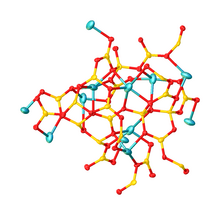
| |
| Names | |
|---|---|
| Other names
Lithium borate
| |
| Identifiers | |
3D model (JSmol)
|
|
| ChemSpider | |
| ECHA InfoCard | 100.031.364 |
| EC Number |
|
PubChem CID
|
|
| UNII | |
CompTox Dashboard (EPA)
|
|
| |
| |
| Properties | |
| Li2B4O7 | |
| Molar mass | 169.11 g/mol |
| Appearance | white powder |
| Density | 2.4 g/cm3, solid |
| Melting point | 917 °C (1,683 °F; 1,190 K) |
| moderately soluble | |
| Hazards | |
| NFPA 704 (fire diamond) | |
| Safety data sheet (SDS) | External MSDS |
Except where otherwise noted, data are given for materials in their standard state (at 25 °C [77 °F], 100 kPa).
| |
Lithium borate, also known as lithium tetraborate is an inorganic compound with the formula Li2B4O7. A colorless solid, lithium borate is used in making glasses and ceramics.

